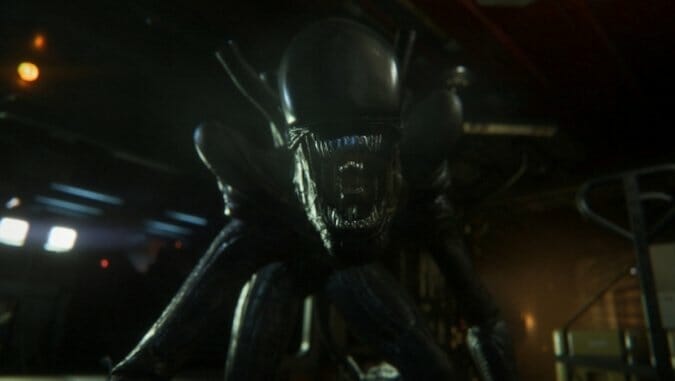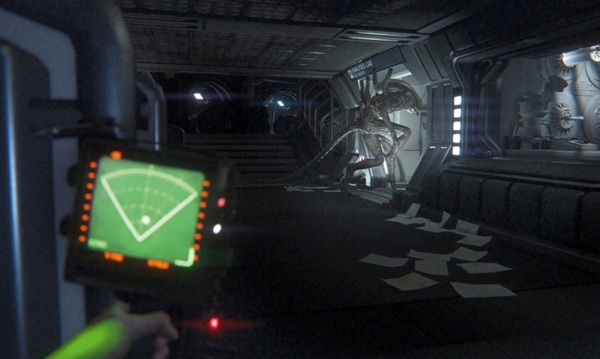
Horror is a more versatile genre than folks often give it credit for being. A good horror story can mean different things for different people. Some might find themselves unnerved by a classic slasher flick or the grotesque body transformations in Cronenberg’s films. My favorite kind of horror story is one where someone learns what it truly means to be held accountable for their choices.
Sometimes, though, truly great horror is a trick of light. It’s the flickering of a bulb in a corridor briefly illuminating the monster hunting you before it scampers off into a ventilation shaft. It’s the blast of light from a dangerous, starved man’s torch as he shines it on your hiding spot. It’s lighting a flare to find shiny jaws of death unclenching before your very eyes. Alien: Isolation is all about the interplay between light and dark, and how both can lead you to your salvation or your doom.
Isolation is the latest in a long line of games based on the Alien franchise, most of which are mediocre at best and controversially abysmal at worst. The game casts you in the role of series protagonist Ellen Ripley’s daughter, Amanda, who has come to the decommissioned space station Sevastopol in search of the truth about what happened to her missing mother. Too bad for Amanda she now has a carnivorous extraterrestrial monster stalking her every move. The story is unremarkable and predictable but succeeds at getting me interested in the history of the station and its fall into bloody chaos. However, I can’t say I care for any of the characters. The ones who aren’t fodder are dull enough that they should be, and even Amanda, whose plight is initially engaging, isn’t particularly that interesting outside of the occasional witty quip (the few times she actually talks).
Luckily, story aside, the Creative Assembly sought to make Isolation stand out by focusing on the claustrophobic, hide & seek survival aspects of Ridley Scott’s original film. It’s a nice contrast to the gun blazing action of James Cameron’s sequel that so many games have emulated. As a result, Isolation is an intense stealth game where being seen by the alien often ends in a quick death. There are weapons in the game, such as a pistol and a shotgun, but they’re often more of a hindrance than anything else. These guns are a designed temptation to lure the player to their doom if they can’t control their itchy trigger finger, as no weapons hurt the alien except for the flamethrower, which only temporarily chases the beast away. Instead, you have to play smart, crafting handheld distraction devices (smoke bombs, flashbangs, “noisemakers”) to outwit the alien and the other threats aboard the station, which include humans and robotic Working Joes.
The power relationships amongst the enemies in the game is one of Isolation’s more fascinating bits. Humans are the weakest enemies, health-wise, though they’re the only ones who can take you out from a distance with guns. Working Joes are slow, creepy-looking rubber face androids that have to get close to the player to damage them; however, these droids are bullet sponges, often taking more than a full clip of ammo to put them down. And then there’s the alien, which is pretty simple to understand. It sees you, it kills you; you can’t kill it, so don’t try. However, the alien will attack other humans (not androids though), which you can use to your advantage. If you have a group of humans blocking an exit you need to get to, you can get them to fire at you and the gunfire will serve as a dinner bell for the big beastie lurking in the vents. You can then make a break for the exit while it picks the group off one by one.
There are opportunities for combat but, with the exception of some areas where you’re all but forced to use weapons, you’re better off sticking to the shadowy corners of Sevastopol, memorizing the patterns of human/android patrols and moving when they’re away. Pattern memorization won’t work with the alien. Hiding is a big part of evading the monster, but it won’t save you. It’s not a predictable beast, and eventually you’ll have to move, creeping from place to place as you consult a terrible map interface in order to find whatever button you need to press or items you need to fetch.
However, no matter how careful you are, no matter how slow or quiet or smart you think you are, you will die. A lot. Sometimes you won’t make a mistake at all, and the alien will just know where you are, and it will find you and eat your face. This is frustrating enough on its own, but it’s a frustration that can be compounded by the fact that there is almost no autosaving or manual saving via menu. Instead, there are emergency checkpoint stations littered throughout each level that you must access to save your game. These stations are a quasi-brilliant mechanic that make the tension in certain parts of Isolation almost unbearable. There were many times where I’d reach one of the stations and wait for the dreaded three second delay to pass before the station saved my progress, deathly afraid that the monster would drop from a vent and snatch me away right before the game saved. It’s a love it or hate it mechanic, but I appreciate what it added to my experience except for one lingering, frustrating quibble: there’s no narrative justification for these stations. They’re artifacts from another era of games where you saved your game by accessing a typewriter or had to have Mei Ling remind you to save your data. There’s obviously a benefit for the player to use them (the ability to load their game) but what’s Amanda’s benefit? It’s never clearly stated, and that’s rather frustrating since this is a game that’s so concerned with the details of the most minute stuff.
Isolation’s aesthetic is a stunning reproduction of the lo-fi tech future envisioned in Scott’s film. Computers look and function like older IBMs. Everything is white and sterile. Monitors resemble old television models instead of expensive flatscreens. Space suits are bulky instead of stylized and slender. It’s an arresting aesthetic and it makes having to backtrack through the station much less of a chore as you’ll likely be examining propaganda posters, bobbleheads and the many nods to Alien as you go. Unfortunately, Isolation’s obsession with doing justice by the series is a double-edged sword.
This is a 20 plus hour game of what’s essentially hide and seek, and, while the first three-fourths of the game are exciting, frightening and tense, in its last five hours the quality of Isolation nosedives and becomes a tedious string of “relive these moments from the movies” levels. During the last two hours, I was literally, vocally begging the game to end. The tense stealth had become dull trial & error. I could predict whatever obstacle the game was going to throw at me long before I got to it. It isn’t engaging and I hated every minute of it.
In spite of that slog, I’ll probably remember the good times I had with Isolation more than the bad. I’ll remember crawling through the vent with a lit flare, praying the monster wasn’t behind me. I’ll remember stepping over a corpse, my eyes glued to the dots on my motion tracker, ears listening to the walls. I’ll remember hiding in a locker, peering out at the monster as drool falls from its mouths and I wait for my chance to run.
It’s also really hard for me to be too disappointed with a AAA game that’s actively opposed to being just another power fantasy game starring a man who shoots people for his country or himself. Isolation tries to do a lot of interesting things and is for the most part successful. I just wish a decent endgame had been one of them.
Alien: Isolation was developed by The Creative Assembly and published by Sega. Our review is based on the Playstation 4 version. It is also available for PC, Xbox One, Xbox 360 and Playstation 3.
Javy Gwaltney devotes his time to writing about these videogame things when he isn’t teaching or cobbling together a novel. You can follow the trail of pizza crumbs to his Twitter.
